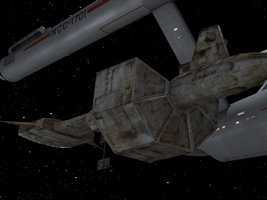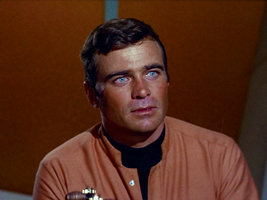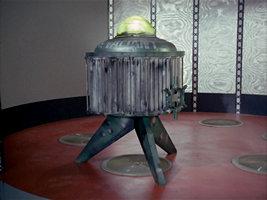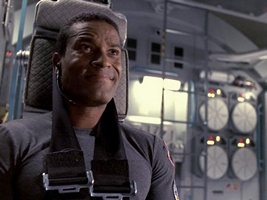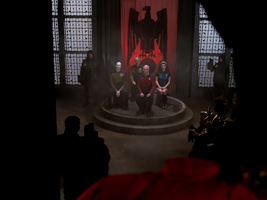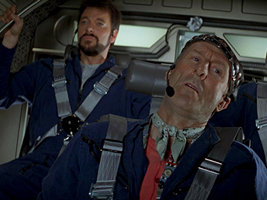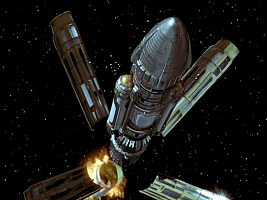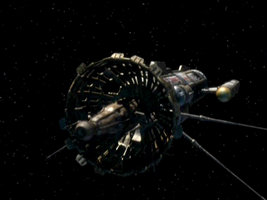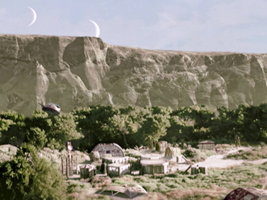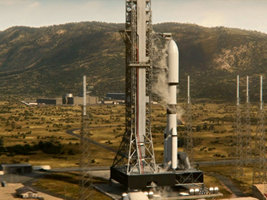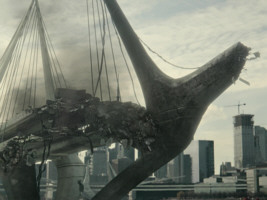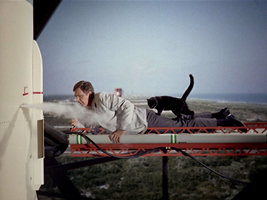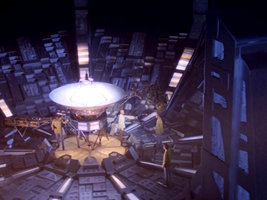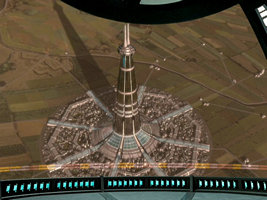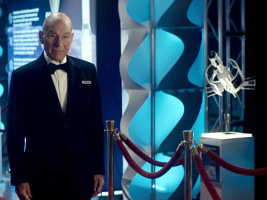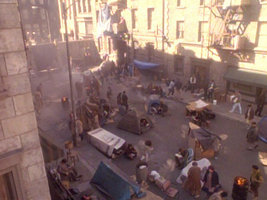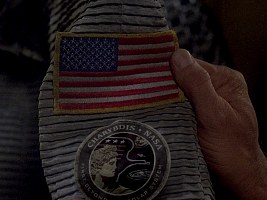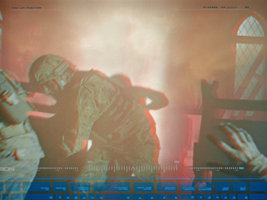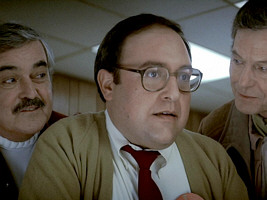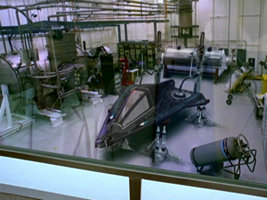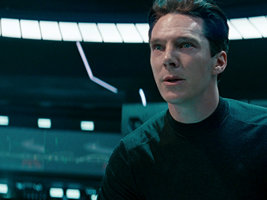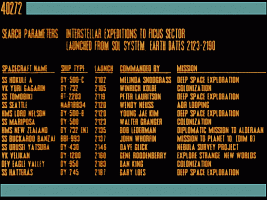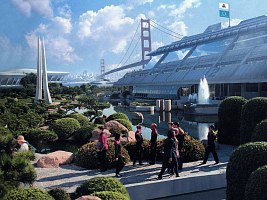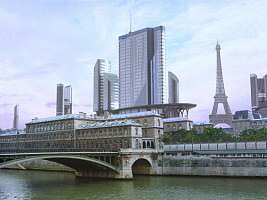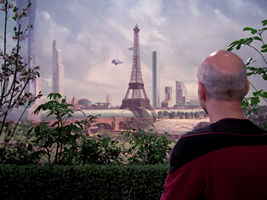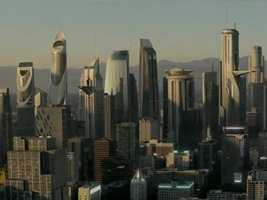21st Century Earth History
ChronologiesDiscussionTheoriesCommentary on the Khan Retcon
When Gene Roddenberry conceived Star Trek in the 1960s, he did it in a climate of enthusiasm about space travel and other evolving technologies. With the first manned Moon landing to happen before the end of the decade, it seemed plausible that Mars would be in reach perhaps ten years later, and that the future of humanity would lie in space. The authors of Star Trek came up with utopian technologies such as warp drive or the transporter to set apart the world of the far future from the expected developments in the next couple of decades. But they were too optimistic when they predicted genetic engineering, cryogenic chambers and interplanetary vessels to become a reality before the end of the 20th century, technologies as seen on Khan's ship in TOS: "Space Seed".
To everyone's credit, no one could have expected that Star Trek would evolve to a franchise that would actually see the year 1996 when Khan's people were said to depart from this planet aboard the Botany Bay. We still have Star Trek today, but we know that part of its history didn't happen. The authors of later series noticed the growing divergence between the 20th/21st century in Star Trek and in the real world, and from TNG to ENT they gradually revoked some of the innovations that, according to TOS, should already exist. This temporarily brought back the synchronization between our time and the Star Trek Universe, but it turns parts of the established fictional history into a mess.
The latest series PIC and SNW brought still another paradigm shift because they openly acknowledge that a divergence exists between the early 21st century as seen in Star Trek and the real world. In more drastic words, they posit that Star Trek takes place in an alternate timeline.
Chronologies
I have classified the most important events of Earth's history of the 20th to the 22nd century, taken from my timeline section, grouping them into seven categories.
TOS
The history according to TOS saw interplanetary flight and genetically enhanced humans as soon as at the end of the 20th century. The Eugenics Wars, sometimes referred to as the last World War, took place in the 1990s. After that, Earth must have recovered relatively quickly, and soon new ambitious space projects were launched to explore the whole solar system. This was followed by the development of warp drive some time in the mid-21st century.
1992 Khan Noonien Singh rises to power, assuming dictatorial control from South Asia to the Middle East. Khan is the product of genetic engineering and eugenics experiments (TOS: "Space Seed", "Star Trek: The Wrath of Khan").
The exact date and the era of the "late 20th century" were stated in the TOS episode and the movie, respectively. However, interestingly on both occasions the time of the Eugenics Wars was also referred to as "200 years ago". The reason for this discrepancy is easy to explain. TOS was intended to take place about 100 years earlier than the later established date of 2265 - in which case it would be correct that 200 years have passed since the late 20th century. With TOS set in the 23rd century, we may either accept the absolute dates with the difficulty of justifying the divergence between Khan's and the real timeline, or we may go with the relative dates which could be better harmonized with other Trek events of the late 20th and the 21st century.
1996 Earth's Eugenics Wars are over, as Khan Noonien Singh is overthrown. Khan escapes on a DY-100 class sleeper ship named S.S. Botany Bay with 96 of his fellow genetic supermen (TOS: "Space Seed", "Star Trek: The Wrath of Khan").
Obviously neither genetic engineering nor space travel is that far advanced in our real world, and the political and military events haven't taken place either. VOY: "Future's End" is set in this very year. There is a model and a photo of the DY-100 with booster rockets in Rain Robinson's office, but nothing else related to the Eugenics Wars seems to exist in this episode which is -except for Starling's Chronowerx- exactly the same as the 1990s as we know them.
2018 Advances in sublight propulsion technologies make the sleeper ships obsolete (TOS: "Space Seed").
All later episodes without exception assume only moderate advances in propulsion technology in the early 21st century, in a way that interstellar travel, no matter if with sleeper ships or with the new technology, wouldn't be feasible until the invention of warp drive.
2030 Zefram Cochrane is born (TOS: "Metamorphosis").
Why did he look much older than 33 in "First Contact"? Radiation damage? Moreover, his birth year is much too late compared to the launch date of the S.S. Valiant (from the second pilot, produced two years earlier). It is very hard to believe that Cochrane would have developed warp drive as a teenager. So even within TOS there are discontinuities.
2065 The S.S. Valiant is the first Terran vessel to leave the galaxy. During the crossing of the galactic barrier some crew members develop superior ESP powers, and the captain finally initializes the self-destruct (TOS: "Where No Man Has Gone Before").
It seems very unlikely that only two years after Cochrane's flight ("First Contact") a fully-fledged starship leaves the solar system, and even less credible that it could ever reach the edge of the galaxy.
Around 2117 Cochrane, now living on Alpha Centauri, leaves the planet with an unknown destination. He is believed to be dead (TOS: "Metamorphosis").
If we don't want to completely disregard Kirk's line "Cochrane, of Alpha Centauri?", we must assume that Cochrane later moved to this planet.
2123 The S.S. Mariposa is launched for colonization of the Ficus sector. The craft settles colonists on Bringloid V. It later crashes on the planet Mariposa while attempting to settle a second group of colonists. There are only five survivors of the crash, who attempt to keep their colony viable using cloning technology (TNG: "Up the Long Ladder").
The settlers used a DY-500 vessel, a tip of the hat to the DY-100. The design lineage, as well as the fact that space travel was regarded as routine already then, is the reason why this one TNG episode would better fit into the TOS version of history - although it explicitly mentions the Third World War too.
TNG/DS9/VOY
The second generation of Star Trek starts off with a revised history that outlines a development largely identical to our real world. No genetically enhanced humans or interplanetary travel exist at the end of the 20th century, and the space projects of the following decades have only moderate goals. A global war devastates Earth by the mid-21st century, requiring a difficult recovery of the planet. Nevertheless, this era also sees the development of the first operational warp vessel.
2032 The ISA spacecraft Ares IV with Lt. John Kelly vanishes in a subspace ellipse while in orbit around the planet Mars (VOY: "One Small Step").
Why is the Ares IV so primitive if there existed much larger and more advanced ships of the DY-100 class already 40 years earlier?
Around 2050 World War III devastates Earth. 600 million are killed and many of the major cities destroyed, the governments and legal systems largely collapse (TNG: "Encounter at Farpoint", "A Matter of Time", "Star Trek: First Contact").
The death toll of 37 million mentioned in TOS: "Bread and Circuses" (without providing a date) was much lower. In DS9: "Dr. Bashir, I Presume", the date of the Eugenics Wars is given as 200 years before the episode, which would be approximately 2173, more than a hundred years later. The simple explanation for this blatant mistake is that Ron D. Moore took the (already wrong) 200 years from "Star Trek II", disregarding that 2373 is still some 90 years later.
2063 Zefram Cochrane's Phoenix is the first manned Earth vessel to achieve faster than light speed. After the project has been endangered by a sudden Borg attack, the Enterprise-E crew helps Cochrane to complete the mission. A Vulcan survey ship notices the Phoenix's warp signature and makes first contact with the inhabitants of Earth ("Star Trek: First Contact").
The movie makes it quite clear that going into space is something unheard of for most people living on Earth, as Lily's and Cochrane's emotional reactions clearly show. Since they grew up before the Third World War, according to the now obsolete TOS chronology they could well have been in space before.
2079 Earth continues the difficult recovery from the Third World War. In many regions of Earth the legal system is still based on the principle of "guilty until proven innocent" (TNG: "Encounter at Farpoint").
Maybe this applies only to certain regions of the planet, not to lucky North America.
Before 2168 A group of settlers leaves Earth for the Moab IV system, to form a perfectly balanced society. They have no knowledge of transporter technology, not even of its basic physics (TNG: "The Masterpiece Society").
This will be more or less contradicted in Enterprise, where a fully operational personnel transporter exists as early as 2151.
VOY/ENT
This is another (slight) revision of history. It is identical to the TNG/DS9/VOY timeline up to Cochrane's warp flight, but then, even largely without Vulcan help, sees an extremely fast development of Earth's technology (Friendship One, Conestoga). Ironically, almost no further progress takes place until more than 80 years later when Enterprise NX-01 is commissioned. After this second quantum leap, there will be again no noticeable progress for some 100 years.
Roughly 2050 Jonathan Archer's great-grandfather is fighting in the Eugenics Wars (ENT: "Hatchery").
Jonathan Archer was about 10 years old in 2121, his father looked like 40 at that time. Jonathan's grandfather was born around 2040, give or take 20 years. The Eugenics Wars should have been roughly during that time, almost definitely not 1992-1996.
2061 Something decisive happens that solves Earth's problems with limited fossil fuel (ENT: "Carpenter Street").
On T'Pol's remark that Earth's fuel resources are depleted, Archer says that humans were well aware of that, "until 2061, when they finally..." It does not become clear, but he may refer to the discovery of a new power source, possibly fusion. It can't really be antimatter, as this would have to be produced with lot of energy in the first place, although it might fit with Cochrane's warp flight two years later. In any case, the date seems questionable, as it would fall in a time of general chaos after the Third World War, if we assume the war was that destructive.
2067 Friendship One is launched from Earth. Only four years after Cochrane's successful warp flight it is a deep space probe to contact other civilizations (VOY: "Friendship One").
It remains a mystery how, only four years after Cochrane's one-minute flight, Earth was able to launch a probe that would work for centuries.
2067 The colony ship Conestoga leaves for Terra Nova (ENT: "Terra Nova").
Yet another way too early launch of a long-distance warp ship (the third project of this kind after Valiant and Friendship One!). The Conestoga must have been a large self-sustaining ship for dozens of settlers, and it is questionable how this could have been achieved only four years after Cochrane's brief flight with a primitive tiny ship that built with all kinds of scarce materials. It could be that the Vulcans helped launch the Conestoga, but the episode made it clear that the humans did it on their own.
2119 Zefram Cochrane officially opens the Warp 5 complex to build the fastest human starship (ENT: "Broken Bow").
If we are generous, we may take 2117 as the year of Cochrane's disappearance from TOS: "Metamorphosis" as an approximate date.
2151 First contact between humans and Klingons takes place. The starship Enterprise NX-01 is launched under the command of Jonathan Archer. It is the first starship built by humans to achieve Warp 5. It is also the first starship equipped with a transporter for biotransport (ENT: "Broken Bow").
The transporter aboard the Enterprise is inconsistent with the fact that the inhabitants of the colony on Moab IV (TNG: "The Masterpiece Society") still have no knowledge of the existence of this technology in 2368, unless they left Earth long before 2151 (the colony was founded around 2168).
PIC
When Picard and company travel to the year 2024 in the second season, there is a NASA program of manned interplanetary flight and other technologies that don't exist in the real world. This is still in line with the VOY/ENT chronology. However, for the first time in the franchise, a discrepancy between the 21st century of Star Trek and of the real world is acknowledged.
2024 Adam Soong has developed a shield technology to block harmful radiation, allowing his daughter Kore to stay outside the house (PIC: "Fly Me to the Moon").
No such technology exists in real life.
2024 Despite repeated attempts by Q and Soong to dissuade or kill her, NASA astronaut Renée Picard embarks the Europa Mission on April 15, thanks to help from Picard, his crew and Supervisor Tallinn (PIC: "Farewell").
This space program is much in line with the Saturn mission from TOS or the Charybdis from TNG. Yet, it is the first time in Star Trek that a technology or big project is established that does not comply with real-world developments.
2024 Adam Soong opens a drawer with an old folder from the 1990's, labeled "Project Khan" (PIC: "Farewell").
The history of Khan is clearly retconned. Not Khan's rise to power but either his creation or merely the project plan dates back to 1992. The folder itself is from 1996, after which the project may have been (temporarily) shelved.
2024 Atmospheric pollution is one of the most pressing problems on 21st century Earth. Rather than a shield technology by Adam Soong, the discovery of a microbe by Renée Picard on the Europa mission is the key to cleaning up the skies (PIC: "Assimilation", "Farewell").
Late 2020's Temporal agents blow up the Lake Ontario Bridge in Toronto. Time-traveling Romulans plan to destroy a cold fusion reactor in a science institute (which is successful in one timeline) or to assassinate Khan, who is still a little boy. The plan is thwarted by Kirk from a parallel timeline and La'an Noonien-Singh (SNW: "Tomorrow and Tomorrow and Tomorrow").
The events shown in the Strange New Worlds episode comply with what has been established in the second season of Picard. Earth does have advanced technology that doesn't exist in the real 2020's. The Eugenics Wars are obviously still supposed to happen. Sera, the Romulan agent, specifically says she waited 30 years, since 1992, to get her shot at Khan. It is more like 40 years considering Khan's age, maybe a few years less if the boy grew rapidly after Adam Soong had resumed the project in 2024. Anyway, she must have been aware of the old file that Soong pulled off the drawer in PIC: "Farewell". In a more daring interpretation, the intention could be to tell the viewers that Khan could have happened in 1992, and perhaps did happen in some other universe. It appears to be trick to allow TOS history to co-exist with the one of the later series.
Common
These are some events that are historically relevant, but would fit into any of the different versions of history, sometimes with a bit of tweaking.
1968 The Enterprise travels back to the Earth of this time where Gary Seven is on a mission to prevent a nuclear war. In the course of the events a nuclear warhead explodes only 100 miles above Earth's surface, as a warning to humanity (TOS: "Assignment: Earth").
Strictly speaking, the divergence between TOS and the real world already begins in 1968 when, in the TOS version of history, the USA have nuclear warheads ready to launch, mounted on a civil Saturn rocket, and are even going to install orbital weapon platforms. But since at least the required single technologies may have existed as of 1968, I think we can neglect this divergence from our actual history. We also wouldn't think that it's a parallel universe only because there was no mysterious guy called Gary Seven in New York at that time. It is no parallel timeline either, since we are dealing with the predestination phenomenon here: everything is supposed to happen exactly as it is recorded in history books.
1969 The Enterprise accidentally travels back to Earth when passing by a black star, an effect that will later be known as the slingshot effect. The ship is detected by Air Force pilot John Christopher. A possible damage to the timeline is repaired, so that no records exist of the incident (TOS: "Tomorrow is Yesterday").
Note that, in the airing sequence, this event comes before the Enterprise's above intentional travel to the year 1968. The outcome of the episode creates the impression that the timeline could be completely restored in the end. There is no need to make up a different timeline where there is no visible divergence.
Late 20th century The technology of genetic enhancement used for the Augments is developed (ENT: "Borderland", "The Augments").
An exact date of the Eugenics Wars was not given in the story arc. Phlox's statement that the technology comes from the 20th century does not necessarily imply that the wars took place as soon as 1992. I suppose that the rather blurry statement was purposely inserted to allow to further pursue this interpretation (although it has been contradicted so often), while adhering to the revised Trek history in which there was no such thing as a global war going on in the 1990s.
1994 Claire Raymond dies of an embolism. Her husband, Donald Raymond, has her cryogenically frozen and sent into space for possible revival at a future date (TNG: "The Neutral Zone").
Present-day cryogenic procedures are not likely to preserve living organisms in a state that would allow later reanimation, as it causes damage to tissues and it is only applied as late as a person is already declared dead. But then again, it's science fiction, and we may believe that miraculous 24th century medical technology may be able to bring them back to life. In any case, there is no problem with the fact of persons being frozen after their death, as this is an actual procedure performed at the end of the 20th century. As satellites like the one shown in "The Neutral Zone" don't exist as of 1994, we could easily claim that the cryogenic chambers were taken there two or three decades later. This still wouldn't explain why the satellite was found so far away from Earth, though - but unlike the technology of Khan's vessel, this may still comply with the course of technology in our real world.
1999 Voyager 6 is launched from Earth. The probe will eventually fall into a black hole, and emerge near a machine planet on the other side of the galaxy, from where it will return in 2271 ("Star Trek: The Motion Picture").
Voyager 6 does not exist in our real world, and it definitely wasn't launched in 1999. Still, this is only a minor divergence from our real world, as it is a probe with existing technology. The problem is the same as with made up companies, individuals or villages (and sometimes even countries) that do not exist in, but would fit in our real world. We should not reject the notion that Star Trek might take place in our timeline only because there was no Voyager 6.
2000 On December 31, 11:59 p.m., Henry Janeway finally gives up his resistance against the Millennium Gate, a huge self-sustaining shopping mall to be built in his hometown in Indiana (VOY: "11:59").
The question about the Millennium Gate is basically the same as with Voyager 6. There is no technology involved that doesn't exist in our time and there is no need to revise history - although a massive building may have more influence on Earth's development than a space probe.
2002 The Nomad probe, constructed by Jackson Roykirk, is launched from Earth on a mission to seek for extraterrestrial life. After a collision with the alien probe Tan Ru Nomad will turn into a deadly weapon seeking to destroy any imperfect life (TOS: "The Changeling", PIC: "Two of One").
Of course, the space probe Nomad doesn't exist either. But it does not seem to include any technology that would be ahead of our time, so everything stated for Voyager 6 applies here likewise. The existence of the probe is conformed in PIC: "Two of One". It is still another problem how a collision with an alien probe could let the two merge to one device that is much more powerful than either of them.
Early 21st century The first ships to explore the solar system were nuclear-powered (ENT: "Borderland").
This statement could easily include any ships of the pre-warp era mentioned from TOS to ENT.
Early 21st century Captain Shaun Geoffrey Christopher commands the first successful Earth/Saturn space probe mission (TOS: "Tomorrow is Yesterday").
Shaun Geoffrey Christopher could be born as soon as 1969 or as late as 1999, and he could command the mission as a young man or a veteran astronaut. We also don't know how soon after the development of a powerful enough propulsion system an Earth spaceship would visit Saturn, a planet that cannot be colonized, but may be of other special interest. Summarizing, we can adapt this event to our needs, although time is running out for it...
2020s The American government creates special Sanctuary Districts for unemployed and homeless people in most major cities (DS9: "Past Tense", PIC: "Assimilation").
2024 Sisko, Bashir and Dax materialize in San Francisco. Sisko and Bashir are taken to a Sanctuary District, where Gabriel Bell, who would save the lives of many hostages, is accidentally killed because of their presence. Sisko saves history by pretending he is Bell. Historical records now list Bell with Sisko's photo as the man who peacefully ended the riot (DS9: "Past Tense").
Although Gabriel Bell's picture in history books is ultimately replaced with Benjamin Sisko's, we get the impression that the course of time is completely restored after this episode. Considering that the most blatant deviation is earlier anyway, this time travel event should not serve as an explanation for the different technological developments.
2025 Ireland is reunited as a result of the ongoing violence as a political instrument (TNG: "The High Ground").
Who knows what still happens after the Brexit? Only the notion that it happened because of IRA bombings remains highly objectionable. And, of course, time is running out.
2033 A 52nd state is admitted to the USA (TNG: "The Royale").
There are enough candidates for two new states.
2036 The New United Nations rules from Earth that citizens may not be held responsible for crimes committed by their ancestors (TNG: "Encounter at Farpoint").
The word "New" is strange, since there would be no reason to assume that the UN would need to be re-established that soon, after all in the revised TNG history the Third World War is supposed to take place later.
2037 NASA launches the spacecraft Charybdis on July 23, commanded by Colonel Steven Rickey. It is the third attempt to explore beyond Earth's solar system. The ship is declared missing after telemetry is lost (TNG: "The Royale").
This story fits into the TOS theory if we assume that the Charybdis is a ship akin to the DY-100 series. Even in a rapid development, it would make sense that, until then, space travel was restricted to our solar system, as there is nothing beyond its borders that would be worth while exploring without warp. If we go with the TNG/DS9/VOY theory, then we can only assume that NASA discovered something interesting beyond the Sol system and that another space race was going on.
2053 The "Red Angel" aka Gabrielle Burnham saves a group of people who have sought shelter in a church during a nuclear attack in WWIII (DIS: "New Eden").
2064 In a commencement address at Princeton University, Zefram Cochrane mentions details about first contact with the Vulcans, including "a group of cybernetic creatures from the future". (ENT: "Regeneration").
This may be taken as a sign that at least North America was civilized again at this time.
2067 British astronomer John Burke of the Royal Academy maps the area of space that includes Sherman's Planet (TOS: "The Trouble with Tribbles").
2103 The colonization of Mars begins (VOY: "The 37's").
ENT: "Terra Nova" establishes that Utopia Planitia already exists in 2067 when the Conestoga leaves for Terra Nova. Whether this is a continuity error depends on the definition of the term "colonization". Maybe the Voyager reference refers to a large-scale terraforming of the planet, rather than only a small outpost.
2105 Eight women are brutally killed in the Mars Colonies by an entity previously known as "Jack the Ripper" and later known as "Redjac" (TOS: "Wolf in the Fold").
Around 2110 A United Earth Government is established ("Star Trek: First Contact").
Uncertain
Events that may have taken place only in a different timeline, or that may have caused the different versions of history in the first place.
1967 The timeship Aeon from the 29th century crashes in the High Sierra in California, and is salvaged by Henry Starling who will exploit its technology to found the company Chronowerx and initialize the computer revolution (VOY: "Future's End").
1986 Kirk, Spock, McCoy, Sulu, Scott, Uhura and Chekov visit Earth with a Klingon Bird-of-Prey to take humpback whales to the future. They give Dr. Nichols of the Plexicorp company the formula for transparent aluminum ("Star Trek: The Voyage Home").
The events in "The Voyage Home" bear a big problem, as Scotty sees no problem in revealing to a 20th century company the formula for transparent aluminum, a material that is not supposed to exist for a long time. And this is only the most blatant violation of temporal integrity in the movie. It should have altered history considerably. This should have become quite obvious upon the Bounty's return from the 20th century (assuming that, as usual in such episodes, they were somehow "shielded" against paradoxes), but the 23rd century was unchanged. If even the 23rd century is not visibly affected, we can hardly expect that it has any effect only a few years after the premature invention of the material - assuming that different timelines can only become increasingly divergent and would not converge to an identical common future. Specifically, it seems unlikely that the events in "The Voyage Home" could have triggered a different development that could have caused Khan's rise to power only six years later, much less could the development of an unrelated technology enable interplanetary flight or genetic engineering.
1996 Microelectronics tycoon Henry Starling mysteriously vanishes after an explosion in his office building. It will remain unknown until the 24th century that, in the course of a time loop, he is trying to travel to the 29th century which is finally broken when his timeship is destroyed by Voyager (VOY: "Future's End").
In 1967, the timeship Aeon from the 29th century crashes in California, and its parts are exploited by Henry Starling. By 1996, he has become a computer tycoon, and the microelectronics revolution "was not supposed to happen", as stated in the episode. So is this a parallel timeline? Well, we get the impression that the whole mess with the timelines in the episode was finally cleaned up when Starling was stopped by Voyager in the end. Yet, this "deus ex machina" solution is dubious, to say the least. We also know that Captain Braxton, or at least one version of him, actually spent his 30 years on 20th century Earth after crashing with the vessel (VOY: "Relativity"). Moreover, a browser called "Browser Hound" by the company Chronowerx shows up in VOY: "11:59". Anyway, at least the intermediate timeline (everything we see in the episode of L.A. in 1996) may easily be a parallel timeline. But if we look closer, the world (at least outside Starling's office) is not more advanced or in any way different from our real year 1996. Only Starling's leading role in the microelectronics industry does not exist in our world. But then, any movie with fictional characters would be in a different timeline. Considering that in movies hardly anyone uses Microsoft software, we may even explain Starling's graphical computer interface as being a standard software of the year 1996 - although it is the more obvious choice that it has been developed based on the timeship's technology and that, once the timeline is restored, everyone will (have to) use Bill's instead of Henry's products again.
Problematic
These are retcons and reboots that don't fit with facts established elsewhere.
Late 20th century Khan Noonien Singh and his followers are created via genetic engineering. In this reality, Khan has a different ethnicity than previously established, and he possesses a blood composition to resurrect the dead ("Star Trek Into Darkness").
Even if we posit that visual continuity does not need to exist, in TOS: "Space Seed" Marla McGivers says about Khan: "From the northern India area, I'd guess. Probably a Sikh." Benedict Cumberbatch doesn't look like that at all. To be fair, Ricardo Montalbán was Mexican and didn't have the correct ethnicity either. Anyway, the other elephant in the room is that Khan, as a creation of the late 20th century, has miracle blood in the reboot movie. This is totally absurd.
After 2024 Earth is devastated by a series of wars: the Second Civil War, the Eugenics War, World War III. 600,000 species are eradicated, a third of Earth's population dies (SNW: "Strange New Worlds").
This statement confirms that the Eugenics Wars are not a conflict that took place in the late 20th century as originally intended. It hence complies with previous retcons, such as lately in PIC: "Farewell". On the other hand, it now becomes a war that started as the "Second Civil War" in the USA, quite unlike any theory we might have about Khan and about global politics. Also, the death toll is a lot higher than even in "Star Trek: First Contact". Pike may have exaggerated and he may have vastly overestimated the role that the internal conflict in the USA may have played as the cause for a global nuclear war. As he breaks the fourth wall as blatantly as probably never before in the franchise, we may have to take this with a bigger grain of salt as usual. In the second-season episode SNW: "Ad Astra per Aspera" the death toll of the Eugenics Wars is merely "tens of millions", in line with TOS again. Although these may be just the deaths before the nuclear war broke out, it casts further doubt on Pike's statement.
Discussion
First of all, to allow a sensible discussion, alternate timelines as an explanation for different versions of history should be ruled out - at least for a start. If we allowed parallel timelines, it would put an end to any attempt to rationalize things before it has begun. Ultimately, with parallel timelines we could manipulate anything inconsistent in the series until it fits perfectly. But this is neither fun, nor do I think it is intelligent. Moreover, screwing up history could never produce entirely different timelines that converge again after 100 or 200 years, just in time for important events in the history of the Federation or Starfleet, which we know will always remain a constant. This would be in conflict with the second law of thermodynamics.
Let us try to tie the events from the single episodes together in a different fashion. If we attempt to reconcile the facts from TOS and the later series, we should pay rather attention to the fictional date, and not to the airing date of the episode. In other words, it would be unsuited and also unfair to invalidate TOS facts only because there is one later episode in disagreement with it. Matters are different if a whole chain of events mentioned later draws a completely different picture of history.
TOS: "Space Seed" vs. real year 1996
The whole history around Khan's rise and decline, the Eugenics Wars, genetic engineering and the sleeper ships is the most obvious deviation from real-world history as well as from any of the various revisions of Star Trek history. Considering Khan's age, genetic engineering in TOS must have existed since the early 1960s, unless he was genetically altered to grow up much faster. We may also consider the possibility that he is not the result of a genetic experiment, but of a breeding program, so it may have been just inaccurate or maybe propaganda that he referred to himself and his followers as "genetically enhanced" while they are actually only selected. The problems of early space travel, on the other hand, may not be explained so easily. In the TOS timeline, commercial space ships traverse our solar system as soon as 25 years after the first Moon landing. In any case, an incredibly fast progress must have taken place from the airing date of the episode (1967) to the year 1992.
The year 1992 was still in the far future when "Space Seed" first went on air and it was still possible that this future might come to existence, even if the progress seems unrealistic in retrospect. But now that our real world has passed by the time of Khan without anything like that happening, we need explanations. We could argue that the whole of Star Trek takes place in a different timeline, triggered by a time travel event. This was a more or less accepted solution until screenplay writers began to rewrite Star Trek history or to reconcile it with events in our real world. At latest since "Future's End" it is in sync with real-world technology again. This was a good decision at the time, as it kept Star Trek as "our" future and not the future of some alternate timeline. On the other hand, to explain the discrepancies completely, it would require not two, but even three different timelines: the one of our real world, the TOS one and the revised Trek timeline.
 Voyager, Enterprise and Picard all assumed, at least silently, that the Eugenics Wars happened in the 21st century. The latest show Strange New Worlds is very explicit in this regard. It equates the Eugenics Wars with WWIII in the pilot episode "Strange New Worlds" and pushes the birth date of Khan accordingly forward in "Tomorrow and Tomorrow and Tomorrow". Showrunner Akiva Goldsman explains:
Voyager, Enterprise and Picard all assumed, at least silently, that the Eugenics Wars happened in the 21st century. The latest show Strange New Worlds is very explicit in this regard. It equates the Eugenics Wars with WWIII in the pilot episode "Strange New Worlds" and pushes the birth date of Khan accordingly forward in "Tomorrow and Tomorrow and Tomorrow". Showrunner Akiva Goldsman explains:
"This is a correction. Because otherwise, it's silly, or Star Trek ceases to be in our universe... By the way, this happened in Season 1, so this is not a Season 2 [issue]. It's a pilot issue. We want Star Trek to be an aspirational future. We want to be able to dream our way into the Federation as a Starfleet. I think that is the fun of it, in part. And so, in order to keep Star Trek in our timeline, we continue to push dates forward. At a certain point, we won't be able to. But obviously, if you start saying that the Eugenics Wars were in the 90s, you're kind of fucked for aspirational in terms of the real world."
He doesn't address that the 21st century established in his series (and previously in Picard) is not like the actual timeline we're living in, considering the advanced technology that doesn't exist in the real world, such as forcefields or cold fusion. But he may consider it close enough. He also doesn't mention what exactly happens with the TOS timeline, although the line "This was supposed to happen back in 1992" in "Tomorrow and Tomorrow and Tomorrow" would leave a loophole for it to still exist. But as already mentioned, multiple timelines is the worst possible rationale.
Eugenics Wars vs. VOY: "Future's End"
"Future's End" may be a parallel timeline, and Henry Starling will probably still be a moneyless hippie in the restored year 1996, and not a computer tycoon. It may be used to explain later divergences in history. Still, the technology level established for the allegedly altered year 1996 is exactly what technology was in the real year 1996. No genetically enhanced humans, no interplanetary space travel and, most obviously, no sign of an ongoing world war, the Eugenics Wars. It would not have been mandatory to throw in a reference to the Eugenics Wars, considering that they probably didn't affect the USA too much, but it would have been helpful to create consistency. Without a mention of an enormously important event that was once supposed to take place at the very same time, it appears that it was intentionally left out. On the other hand, "Future's End" has a reference to Khan's vessel, even though the model of the DY-100 in its launch configuration only serves as decoration in Rain Robinson's office. So did the technology exist, only the war never happened? This idea doesn't seem to make much sense.
Lifespan of the DY series
We don't know if the DY-100 series are even the first interplanetary ships. Their length of about 100m indicates that there should have been smaller types before. In any case, this spaceship family is extremely long-lived if we take into account that DY-500 ships were in use as of 2123. The mission chart from TNG: "Up the Long Ladder" even lists several more DY types at later dates. This alone is no inconsistency. But if we look at all the progress that has taken place in the meantime, from the advances in sublight propulsion to the invention and refinement of warp drive and first contact with the Vulcans, and if we also consider that there were one or two world wars in that long time, we would just not expect that a ship of 1996 looks anything like one from 2123. The DY series establishes an isolated design lineage, unaffected by any political or technological changes.
DY-100 vs. Ares IV
The most obvious technological discrepancy exists between the Botany Bay (1996) and the Ares IV (2032). The Botany Bay of the DY-100 series is a fully-fledged 100m long interplanetary vessel, probably capable of reaching remote spots of our solar system with the crew in suspended animation - all technologies far ahead of our time. It may even have artificial gravity, unless we claim that it was created using gravity generators that were transported there from the Enterprise prior to boarding. 38 years later, the International Space Agency ISA uses the spacecraft the Ares IV, whose building principles as well as propulsion and life support technologies are essentially the same as on the present-day ISS. And explores a planet that must have been a regular destination of DY-class freighters for decades. What would interplanetary vessels be used for, if not to visit Earth's closest neighbor planet? This does not fit together at all.
World War III - really that devastating?
According to Riker in "First Contact", 600 million were killed in the Third World War, a considerable part of Earth's population (even though it may rise to some 10 billion by 2050). He also says that all major cities were destroyed, and that governments fell into anarchy. Zefram Cochrane's project was already a small wonder of this time. The breakthrough in power generation mentioned in ENT: "Carpenter Street" must have been another one. But with all major cities destroyed, it is amazing how much old architecture has survived, for instance in Paris or San Francisco. Los Angeles looks much the same in 2401 as it did in 2024, only with some new skyscrapers. Actually, it seems that there is a strange mixture of very old and modernistic building in these cities in the 24th century. It doesn't look like they have been rebuilt (either in consistent old or in new style) after a nuclear destruction, but rather like the chaotic development of cities with old buildings that are arbitrarily replaced with or supplemented with new ones.
 SNW: "Strange New Worlds" aggravates the impact of WWIII, now with over three billion casualties. I personally rather trust in Riker's figures.
SNW: "Strange New Worlds" aggravates the impact of WWIII, now with over three billion casualties. I personally rather trust in Riker's figures.
It is also strange that Picard, at the end of "First Contact", says that he envies Lily for living in her time. He was obviously not thinking of the barbarian "Mad Max" scenario from "Encounter at Farpoint" that was created by Q, although he confirmed it to be authentic of the year 2079. Maybe, while the Western countries quickly recovered, the Eastern Coalition mentioned in "First Contact" was still in ruins as of 2079. We have actually never seen an Asian city in Star Trek (at least not in our timeline), and people of Asian descent are rare. On the other hand, it would be anything but Trek-like if Picard, an enlightened human from the 24th century, ignored or silently accepted that much of humanity wouldn't see any improvement of their situation sixteen years after the contact with the Vulcans.
In PIC: "Farewell", Rios stays in the 21st century to be with Teresa and her son. This would be an extremely odd choice if there were no option to survive in some region that is less affected by the consequences.
Early warp vessels and colonization
In TOS history (Valiant, 2065) and again in VOY/ENT history (Friendship One & Conestoga, 2067) there are huge space travel projects only a few years after Cochrane's flight. Even if the Vulcans helped to get them on the way (which they explicitly didn't in the case of the Conestoga!), it seems that Earth had better things to do than to launch all kinds of costly space missions after World War III. The same applies to the colonization of Moon and Mars. According to ENT: "Terra Nova" there were already bases, maybe even settlements on Moon (New Berlin) and Mars (Utopia Planitia). They may have existed already prior to the World War III, but it is more than doubtful that they were self-sustaining (oh yes, I know that the Millennium Gate was already supposed to be that) and may have survived during the years when it was definitely impossible to supply them.
PIC season 2 and SNW technology vs. real 2020's
The technology level and historical events in PIC season 2 allow no other interpretation but that it is a different timeline than the real world. This may seem like an arbitrary decision by the writers of the series, considering that the story could have been changed a bit to align better with the real year 2024. On the other hand, there are no Sanctuary Districts as in DS9: "Past Tense" in the real United States, and the non-existence of an interplanetary space program would have bought only a few years for the Star Trek timeline until it would diverge anyway.
 The advanced technology mentioned in SNW: "Tomorrow and Tomorrow and Tomorrow" (although we actually don't see it) is further evidence that this is not our 21st century.
The advanced technology mentioned in SNW: "Tomorrow and Tomorrow and Tomorrow" (although we actually don't see it) is further evidence that this is not our 21st century.
Theories
Secret war and secret technology (obsolete)
It has been suggested (notably in the novel series Star Trek: The Eugenics Wars) that the Eugenics Wars were secretly ongoing wars and that the technology has been secretly developed too, so it would be still possible for Star Trek's 20th century history to take place, either in our time or the possibly parallel timeline of "Future's End". On the other hand, Spock made quite clear as soon as in "Space Seed" that it was an open rise to power ("...absolute ruler of more than a quarter of your world. From Asia through the Middle East.") and an open war that ended with the people freeing themselves of Khan. In ENT: "Borderland" the death toll was explicitly given as 30 million. An amazing similarity to the 37 million supposedly killed in World War III as mentioned in TOS: "Bread and Circuses". Jonathan Archer's great-grandfather participated in this war as a soldier, not a secret agent. We would know through CNN if a war with millions of casualties was raging.
Secret research that could have made all the necessary innovations possible is no credible concept either. Considering that even the strongest national economies of our time combined are barely able to maintain projects like the Space Shuttle or the ISS, how could anyone make all the necessary research, design, build and launch a large interplanetary vessel and then even keep it absolutely secret? 20th century dictators with secret spaceships for their escape reminds me rather of James Bond movies than of Star Trek. It also seems unlikely that a secret vessel type would evolve to a whole family of starships being built for much more than a century.
Of course, this theory is obsolete at latest since the makers of Trek have ruled that Khan would rise to power some time after 2024 (PIC: "Farewell", SNW: "Strange New Worlds", "Tomorrow and Tomorrow and Tomorrow").
Commercial vs. experimental technology
One theory is that the Trek timeline is indeed different from ours. The DY-100 class exists in the Trek Universe as of 1996. The reason why Ares IV looks so "primitive" is that it was built as a research vessel. With space travel already far evolved, it was not the first series of exploration of Mars, but just one in a long line.
This theory may help to explain the most blatant visual inconsistency, but doesn't help in any way to fix the other problems. Moreover, the explanation is quite shaky, considering that in "One Small Step" Ares IV was explicitly called "an early Mars mission", as also the episode title very unmistakably insinuates. What could be so exciting about Ares IV going where commercial vessels have gone very often before?
Time travel messes up history
Now for the time travel theory that I shun for good reasons. The two time travels that are the best candidates (unless it is yet another, still unknown temporal event) are Scotty's interference in the year 1986 and Starling's interference from 1967 to 1996, both of which may have erased Khan's reign from time.
The problem with the first idea, blaming Scotty, is that 1986 is already too late to change the course of events that ultimately leads to the Eugenics Wars and the sleeper ships. Also, the basic technologies must already exist at this time, and even if Kirk's crew mess up the late 20th century, it is unlikely that they may hold the technological development for more than a decade. On the contrary, if anything, they should advance it by the introduction of transparent aluminum. The latter argument applies even more in the case of Starling. He acquires technology from the crashed ship from the 29th century. It would be paradoxical if this slowed down the technological development. If we try to reason the other way round (that Starling actually enabled Khan), we have the problem of explaining why Khan existed in TOS, which logically came before Voyager.
Ultimately, another time travel event that may have logically taken place any time in late TNG or early Voyager may explain all the discrepancies. Considering that Trek takes place in a separate timeline according to the latest retcon, a time travel could serve as an explanation. But everything more specific would be mere speculation.
Eugenics Wars and World War III are identical
In order to explain most of the above problems, we need to disregard one fact although it was clearly stated on screen - namely the date of the Eugenics Wars. In my favorite theory the Eugenics Wars are actually the same as WW III, and this took place around 2050. This would also perfectly fit with Archer's statement that his great-grandfather took part in that war, as well with the relative dates given for the Eugenics Wars in TOS: "Space Seed" (200 years ago) and in DS9: "Dr. Bashir, I Presume" (300 years ago). The Eastern Coalition of "First Contact" would be identical to Khan's empire. As for the actual reasons, the course and the death toll of the war, there may be considerable differences depending from where the information is taken, so this may be still a matter of interpretation 200 or 300 years later.
 SNW: "Strange New Worlds" canonizes the idea that the two wars are essentially the same, although it unfortunately links them to a "Second Civil War" that Pike insinuates started it all.
SNW: "Strange New Worlds" canonizes the idea that the two wars are essentially the same, although it unfortunately links them to a "Second Civil War" that Pike insinuates started it all.
Side note The Eugenics Wars have already been retconned in the German translation of TOS: "Space Seed". Here they take place "around 2090" for some reason instead of 1990.
The DY-100 and the technology of its time (2050) would be allowed to be more advanced than the Ares IV and the Charybdis. It would also reduce the lifespan of DY-class ships and help to rationalize the similarity of DY-100 and DY-500, which would be only some 60 years apart, and not 120. Finally, it would explain the absence of a major war in 1996, and the Star Trek timeline could still be mostly identical to our real-world history (which I think is an important point even though certain discrepancies are deemed acceptable by the producers now).
A couple of questions remain. For instance, why was there such a fast miraculous recovery of Earth after World War III (aka Eugenics Wars)? Maybe the impression that the war did not revert Earth to a barbaric state is correct, unlike what could be seen in Q's re-enactment or what Riker (not to mention Pike) said about it. Maybe the USA was one of the countries prospering soon after the war again. Still, it remains a mystery how a planet or country whose technology and economy is barely fit to launch a primitive warp prototype (and even this effort looks quite questionable in "First Contact") will be able to engage into several huge space projects only a few years later, namely the Valiant, Conestoga, Friendship One and the colonization of Moon and Mars. Any of them alone would have been implausible enough.
But if we presuppose that WW III was less devastating than "First Contact" and modern Trek make us believe, we could find a quite easy excuse for the advanced warp vessels that followed the Phoenix. Cochrane may not have been the only one working on a warp drive development project. It is also well possible and even very likely that an unmanned probe had broken the warp barrier prior to the Phoenix. Cochrane may have been the first human at warp by chance, while government or publicly funded institutions, namely the UESPA, were working on Friendship One and the Conestoga. Still, who would build the huge Conestoga as the first warp ship instead of beginning with something smaller and much more reasonable?
Commentary on the Khan Retcon
Now that SNW: "Tomorrow and Tomorrow and Tomorrow" has aired, there is a lot of talking about how this story changes the timeline by postponing Khan's birth and the Eugenics Wars. Some critics go as far as saying that this effectively erases The Original Series.
I am surprised about the outrage, or about this outrage coming so very late. As this article demonstrates, the retconning of Star Trek's history of the 20th century actually goes back all the way to the days of Voyager, and in some respects even to TNG. Whenever the Trek series of the 1990's either went back in time or referenced the 20th/21st century, there was never the slightest sign of a global war or of genetically engineered superhumans. Also, there was never any spaceflight technology far ahead of what already existed in the real world - no interplanetary freighters like the Botany Bay but only Apollo-like missions to neighboring planets, still as late as 2032. To be more precise, per VOY: "One Small Step", ISA launched its pioneering flights to Mars - some 40 years after Khan already had a fully fledged interplanetary vessel! This will never make sense, as hard as we may try. Yes, they also did show the Botany Bay with booster rockets in VOY: "Future's End I". But overall, the late 20th century and early 21st century in Trek was the same as in the real world. It is obvious that the producers of 90's Trek intended Star Trek to become (or remain) the future of our own history, and not of some parallel and increasingly diverging fictional universe.
When I first wrote up this article over 20 years ago, my decision was that Khan and the Eugenics Wars would work a lot better if they were postponed and if the 20th/21st century of Trek were kept in sync with our real world. In my firm opinion, dozens of newer canon facts overrule the mention of the date of the Eugenics Wars in TOS, as definite as it may be. The only piece of evidence still missing was the change of Khan's birth date, but that was no more than a formality. As soon as the character of La'an Noonien-Singh was announced for SNW, I totally expected her to meet her ancestor in some form, and I totally did not expect that to be in the 1990's or earlier. Actually, rather than Khan's exact birth date, making La'an a descendant of the notorious dictator in the first place was a poor decision that damages the continuity of TOS!
The pilot episode of SNW already establishes that Khan must have been born later, considering that Pike more or less explicitly says that the "Second Civil War", the Eugenics Wars and World War III were essentially escalation stages of the very same conflict. All this must have taken place in the mid-21st century, there isn't really room for interpretation. In an interview, showrunner Akiva Goldsman defends the latest decision about Khan's age as a "correction". I think it is not a course correction but merely a logical consequence, whether we like it or not.
It may sound like I agree with all decisions that were made regarding Star Trek's retconned history. That may have been true 20 years ago. But I have two issues with the latest developments as well.
The first is that Trek tries hard to be more like the real world with the retcon. Yet, the 2020's as shown in PIC season 2 and SNW: "Tomorrow and Tomorrow and Tomorrow" are not like our world but only similar. We don't have interplanetary missions, shield technology or cold fusion reactors. Also, it is a bottomless pit because this strategy will require more "corrections" in the future.
The second and more serious concern is that the idea that "Khan was supposed to happen in 1992" as stated in SNW: "Tomorrow and Tomorrow" opens a can of worms. It allows to turn Trek into a shitty multiverse where continuity doesn't matter and where anything may happen anywhere and any time. Time travel in Trek has always been fascinating. Permanent switches to a new universe (such as the Mirror Universe), to a parallel timeline (such as the Kelvin Timeline) or to some other place where things are not as they should be (such as Discovery seasons 1 and 2) never had lasting success, however. The franchise should focus on one timeline or universe. Yet, the blindingly obvious schism between "classic" TOS and "reimagined" SNW should not be resolved by dumping TOS into a discontinued timeline either. Coming back to the outrage about "Tomorrow and Tomorrow and Tomorrow", I agree to some extent with those who complain about TOS being invalidated, but their focus on the side issue of Khan's age distracts from the bigger picture.
See Also
Timeline - Early Space Travel (1967-2160)
Earth Ship Classes - Pre-Federation (prior to 2161)
From the Bonaventure to the Phoenix - ever-changing ideas of the first warp ship
Credits
I would like to thank several people in the Flare Forum for the incentive to care about this topic. My thanks also go to Tom Mendel, Stephen Mendenhall, Erich Mohr and Ruben Hilbers for comments and suggestions.






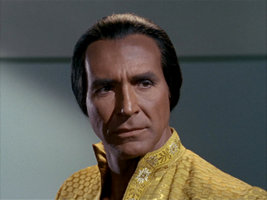
 Khan in TOS: "Space Seed"
Khan in TOS: "Space Seed"